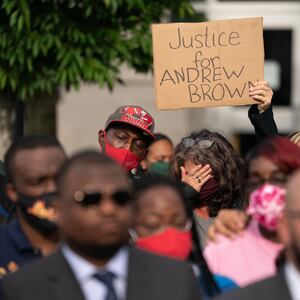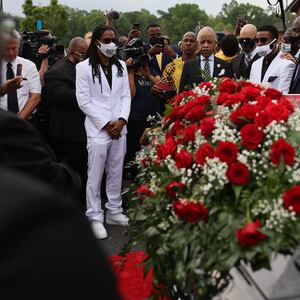ELIZABETH CITY—A North Carolina prosecutor on Tuesday said the police killing of Andrew Brown last month “was justified” because he drove his car at officers serving a warrant, even as the same official showed video that painted a more complicated picture of the 42-year-old Black man attempting to flee.
During a press conference in Elizabeth City, Pasquotank County District Attorney Andrew Womble said the officers who shot at Brown on April 21 will not be prosecuted because they “reasonably believed that the deadly force was justified.” In new body-camera footage released on Tuesday showing the 44-second encounter, Brown can be seen at one point driving away as officers keep firing.
“Mr. Brown’s death, while tragic, was justified, because Mr. Brown’s actions caused three deputies with the Pasquotank County Sheriff’s Office to reasonably believe it was necessary to use deadly force to protect themselves and others,” Womble said.
Despite Womble’s conclusion, Pasquotank County Sheriff Tommy Wooten said on Tuesday that the three officers who shot at Brown will be “disciplined and retrained.” Two deputies who didn’t turn on their body cameras would also be disciplined.
“This was a terrible and tragic outcome,” Wooten said, adding that his entire department would do comprehensive retraining because “we can do better.”
Brown’s family and legal team watched the footage a week ago and said it showed sheriff’s deputies “standing on the pavement unloading their weapons” while Brown was trying to drive away. They’d previously asked Womble to recuse himself from the investigation because of his ties to the sheriff’s department.
On Tuesday, they called Womble’s conclusion “an insult and a slap in the face to Andrew’s family, the Elizabeth City community, and to rational people everywhere.”
“Not only was the car moving away from officers, but four of them did not fire their weapons—clearly they did not feel that their lives were endangered,” the family’s lawyers said in a statement. “And the bottom line is that Andrew was killed by a shot to the back of the head.”
Outside the press conference, a few protesters gathered on Tuesday afternoon. “I think everybody is numb,” said Keith Rivers, president of the local NAACP. “I think ‘numb’ is the best word. Angry. Frustrated.”
He said it was the duty of a district attorney to represent the victim, rather than “justify the actions of the deputy sheriffs.”
By evening, as many as 200 protesters took over Ehringhaus Street, ordinarily a busy five-lane road strung with strip malls and fast-food franchises. North Carolina state troopers and local police seemed to be everywhere.
“Andrew Brown is dead and they’re back at work,” one of them said of the sheriff’s deputies involved. As the protesters set out, the back-and-forth chorus reverberated through the streets: “We’re fired up, can’t take it no more!” and “No justice, no peace!”
Womble said Tuesday that a probe by the North Carolina State Bureau of Investigation found that officers approached Brown’s arrest with caution after a long, drug-related investigation that began when another sheriff’s office received information that Brown had been selling drugs in Dare County. Prior to the arrest, deputies had conducted controlled buys of heroin and cocaine from Brown, Womble said.
On the morning of April 21, Womble said, deputies were briefed on Brown’s criminal history and past interactions with law enforcement—including that he had previously resisted arrest.
It prompted deputies to roll up to Brown’s house at 8:30 a.m. in a casually aggressive manner. In the videos shown Tuesday, several are seen heavily armed in the back of pickup trucks with the gate down. At least one was wearing a backward baseball cap.
Womble said Brown can be seen sitting in his car and holding a phone as deputies arrive. He said Brown “ignored commands” to exit the car. “Brown threw his phone down and rapidly began to back his car away from the officers,” he said.
A deputy can be seen putting his hands on the hood of the car while others shout to stop the vehicle. Womble said Brown backed up and then moved the car forward toward the officers.
“At this moment, Brown was driving directly toward” a deputy, Womble said. While he conceded that Brown was probably trying to flee, he said Brown’s car was being used as a “deadly weapon.”
He said that, due to the severity of the charges against Brown, officers “could not simply let him go, as has been suggested” and had to continue to engage, and arrest, him.
Womble said it didn’t matter how fast Brown was traveling (even a “stationary” car is deemed a threat during an arrest situation, he said) and that every shot was justified, even those fired into the back of Brown’s car.
“If the first shot is justified, the last shot is justified until the threat is extinguished,” Womble added.
Brown’s family and lawyers have directly contradicted Womble’s version of events. After viewing the footage last week, they said Brown was “ambushed by officers” and was only trying to escape being shot.
Family lawyer Chance Lynch said Brown never made contact with deputies, and the gunfire prompted Brown to “put the car in reverse, putting [it] several feet, if not yards, away from the police” before he turned his steering wheel to the left to drive away.
“We did not see any actions on Mr. Brown’s part that he made contact with them or tried to go in their direction. In fact, he did the opposite,” Lynch said. “While there was a group of law enforcement who were in front of him, he went in the opposite direction.”
Eventually, one bullet hit Brown in the head, and he swerved into a tree. An autopsy by the state concluded that Brown had two gunshot wounds—one in his arm and one in his head—and the cause of death was gunshot wounds. Womble added Brown had a bag of crystal meth in his mouth.
An independent autopsy, commissioned by his family, found five gunshot wounds, including one “kill shot” to the back of his head.
Womble insisted that Brown was the initial aggressor and the “facts clearly show officers used deadly force reasonably” when a “violent felon put their lives in danger.”
When asked how he could be so certain that the car was being used as a weapon, Womble said there was no way for Brown to escape unless he drove toward the deputies.
Brown’s death came on the day after Derek Chauvin was found guilty of killing George Floyd and instantly sparked protests that only grew when officials released virtually no details about Brown’s death for days.
Womble said Tuesday that he refused to jeopardize the investigation for the demands of the “24-hour news cycle” and insisted he came to his conclusion after looking at the facts, not “on public opinion.”
Seemingly slamming the Brown family’s lawyers’ commentary, he said “there were falsehoods” made about what occurred in the shooting.
He said communications with Brown’s family had broken down to the point where he didn’t inform them of his decision not to prosecute the officers.
The “relationship is strained to the point where it would not be feasible” to speak to them, Womble said.
But local law enforcement may not have the last word on the incident: The FBI has since opened a federal civil-rights investigation into the killing.
Andrew Brown Jr.’s home, a small, white-brick structure in a residential area just a few minutes from the downtown area, now features a multi-colored mural of him on one wall, with the words “Say His Name” emblazoned under his image. Michael Gordon, 61, a lifelong Elizabeth City resident who lives across the street, sat with a neighbor on the front porch of his white, two-story house late Tuesday afternoon.
“They said it’s justified; I don’t see how,” Gordon told The Daily Beast, adding that Brown was unarmed. He pointed to a bullet hole in the wall of the front of his home, just to the right of his house number. It was left from one of the rounds fired at Brown by sheriff’s deputies on April 21, he said.
“As far as I’m concerned, it was murder,” said the neighbor, who declined to be identified.
“I don’t see why they justified the shooting,” Gordon added. “He was trying to get away…. It’s crazy.”
Brown’s car, which continued moving after he was shot, came to rest against the base of a crepe myrtle tree that sits on Gordon’s property on Roanoke Avenue, across an empty lot from Brown’s home.
“That’s where he died,” Gordon said of Brown. “If I shot somebody, they’d put their knee on my damn neck,” he said, invoking the name of George Floyd: “It’s a disgrace; it’s senseless.”
Gordon and his wife were not home on the day of the shooting. “Thank the Lord… by the grace of God,” he said.
Other neighbors approached by a reporter declined to say anything or simply waved a hand in dismissal. One woman, however, driving on Brown’s street, stopped her car in front of his home, rolled down her window, and, from a few feet away. pointed her finger at the reporter:
“Say his name,” she ordered.
She then rolled up her window and drove away.










